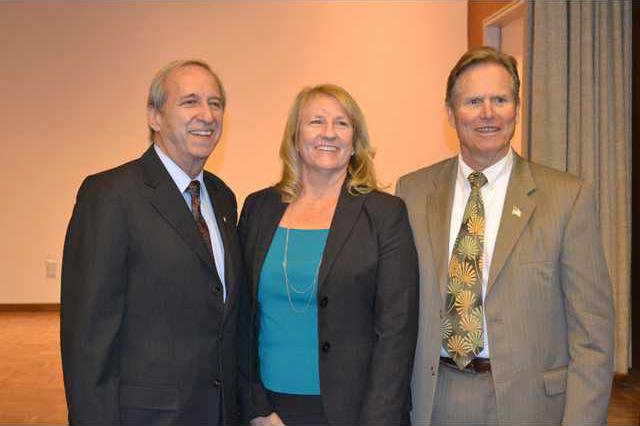It’s not often that representatives from the Stanislaus County Office of Education, California State University, Stanislaus, and Modesto Junior College aggregate into one room.
So when SCOE Superintendent of Schools Tom Changnon, CSU Stanislaus President Joseph F. Sheley and MJC President Jill Stearns gathered at the Modesto Library on Thursday it was for an unarguably good reason: to launch the Stanislaus Education Partnership.
“I am very excited about this formalized partnership,” said Changnon. “It’s always wonderful to work with educational leaders that have a collaborative spirit and together we want to create a pathway where students understand the roadmap to success and to help support them in that endeavor.”
The new partnership includes a number of goals, including increasing college enrollment throughout the region, increasing college graduation rates, reducing the time to a degree, and closing the achievement gap for underrepresented students.
The Stanislaus Education Partnership hopes to guide, promote, and support students in their endeavor to achieve a higher education, by honing in on the practices that have already proven successful.
Changnon highlighted a number of successful SCOE programs that are already in place, including the Come Back Kids program, which offers a high school program for adults over the age of 18 years old who want to come back in order to complete a diploma, and the Arches program, which aims to build a college-going culture among low income and underrepresented students from communities with historically low college-going rates.
“This new Stanislaus Education Partnership hopes to increase these collaborations and smooth the way for students who wish to continue their education,” said Changnon.
Changnon also touched on Destination Graduation, which is a county-wide initiative aimed at increasing graduation rates in Stanislaus County, and how he hoped the new Stanislaus Education Partnership would give students an extra boost towards college once they graduate high school.
“We have launched Destination Graduation to increase the numbers of high school graduates in this county, and this new partnership provides the students who want to go on to college a better opportunity to do so and then to be successful once they enroll,” said Changnon.
Stearns spoke of the collaboration that has occurred over the past year between faculty at SCOE, MJC, and CSU Stanislaus to strengthen the linkage between partners in order to form the Stanislaus Education Partnership.
“I am really excited to embark on this new educational partnership,” said Stearns. “We believe that the formal and purposeful commitment made by SCOE, MJC, and CSU Stanislaus to work together to ensure pathways to higher education for students is a very positive step.”
“On behalf of MJC, we are committed to increasing education rates in Stanislaus County and creating a skilled workforce that is prepared to meet the needs of our local employers,” added Stearns.
Sheley compared college graduation rates in San Francisco at 57 percent to Sacramento rates at 30 percent—two percentages that are drastically higher than the region’s rates, which always fall lower than 20 percent.
“This is a big day for us, not because we have discovered the answer, but because we understand that we can’t keep saying we need more college graduates in the region if we aren’t partnered together and saying together we’re going to help stimulate the conversations,” said Sheley.
Sheley made it clear that there was not just one group to blame or that it was because the region is a resource-challenged environment. Rather, he emphasized the importance of this partnership’s mission to get information about higher education to parents and students as early as possible.
“For starters, we should be finding ways to contact them (parents). We should be explaining to them what kind of financial situation you need to focus on in order to ultimately get your child headed towards college,” said Sheley. “If we are going to open the doors for our kids and keep them here, we have to get going.”
Other speakers during Thursday’s launch were David White from the Stanislaus Business Alliance and Marian Kaanon from the Stanislaus Community Foundation, both of which echoed the importance of increasing the transparency associated with pursuing a higher education.
“This conference does not end it by any means, it only launches it, we have no particular agenda that we are going to follow except to keep our pledge that we are going to meet routinely, touch base, get parents involved, and make sure what we want to happen actually happens,” said Sheley.
The Stanislaus Education Partnership plans to convene quarterly to address areas of progress as well as identify potential challenges. As it progresses, the partnership hopes to better equip students with the tools they need to successfully navigate a path to college completion.









